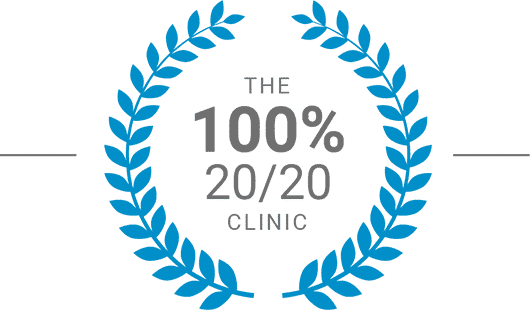Book Your Free Consultation
Mr David Allamby
MD, FRCOphth, FRCS
Uncorrected myopia can be devastating. In 2020, nearly 160 million people worldwide experienced significant distance vision impairment because they didn’t have glasses.
Among them, three million were left blind with a visual acuity of less than 3/60. That means they couldn’t read the huge top letter on the vision chart from just 3 metres away.
Uncorrected refractive error is the leading cause of vision impairment among school-aged children.
Understanding the various types of nearsightedness is vital to effective management and overall eye health.
Myopia is a common refractive error with different root causes and manifests in slightly different forms. This comprehensive guide will delve into these diverse classifications and explore factors impacting myopia progression.
Affecting around 1 in 3 people in the UK, the need to understand and correct myopia is huge — and growing, with increased use of screens causing more cases of myopia.
Beyond identification, we will also illuminate the various methods of controlling and treating myopia.
At Focus Clinics, we emphasise the importance of considered and personalised care, considering individual cases and personal factors to help you find the best treatment possible.
Myopia occurs when the eyeball lengthens (called axial myopia) or, less commonly, when the corneal curvature (the clear dome-shaped surface of the eye) is too extreme.
This means that light rays entering the eye are focused in front of the retina (the light-sensitive layer at the back of the eye, like the digital sensor at the back of a camera) rather than directly on it.
Distance vision becomes blurred as a result, and the following symptoms are typical giveaways of myopia progression:
Myopia in children can be hard to spot, but watch for any of these symptoms. Children may also complain about being unable to see a whiteboard clearly in school or be holding screens too close to their faces.
Myopia development, or any refractive error, is typically a combination of genetic and environmental factors.
Nearsightedness is often inherited, meaning myopic parents lead to an increased likelihood of the child's vision being impacted by the same refractive error. The risk of developing myopia is significantly higher in children with myopic parents.
Research shows that having one myopic parent increases the risk by a factor of two while having two myopic parents increases the risk by a factor of five.
This underscores the importance of understanding and addressing the hereditary factors contributing to myopia to promote better eye health.
Furthermore, both children and young adults who spend excessive time indoors, reading, or looking at screens are more likely to develop a type of self-induced myopia. However, the causes and types of myopia are still far more in-depth.
Due to the possible variance in causes, the types of myopia classification fall into several subcategories.
Pathological myopia development, sometimes called congenital myopia, in children begins anywhere from birth until age 6. This can be myopia of any severity/degree.
School-age myopia develops during childhood and adolescence, from the age of six through until 18 years of age.
The prevalence of myopia developing during these years is more common in industrialised countries, caused by extended time spent reading or looking at screens during education.
Developing myopia during early adulthood is often attributed to those who work in occupations requiring long hours of up-close and near vision focus.
Jobs requiring high screen time, reading, or writing are usually the culprit when myopia develops in adults.
Experiencing myopia progression in adulthood does not necessarily mean your eye health is poor, but it may increase your risk of developing other eye conditions. High myopia, in particular, can make other vision problems more likely, especially degenerative ones.
A refractive error increases the chances of developing glaucoma, whether the prescription is low or high.
For each dioptre increase in myopia, the risk of glaucoma increases by approximately 20%. Overall, a patient with shortsightedness is 1.5 to 4 times more likely to get myopia, depending on the severity of the prescription.
Glaucoma can lead to vision loss and blindness if untreated, so control over the pressure inside the eye through prescribed eye drops is essential.
High myopia levels have been found to increase the chances of retinal detachment, in which the back layer of cells (the retina) peels away from the underlying supportive tissue. The retina stops functioning, leading to a potential permanent loss of vision if left untreated.
Symptoms of retinal detachment include flashing lights, an increase in floaters, or a 'curtain effect' moving up and down or across the visual field.
An eye doctor is the only one qualified to decide whether certain risk factors make retinal detachment more likely for you or if you are already experiencing it.
Cataracts are a common part of the ageing process, developing between 40 and 60.
Caused typically by exposure to solar radiation throughout our lifetimes, cataracts result from changes in proteins within the eye’s lens.
For patients whose myopia progression began in adulthood, especially those over the age of 55, there is a higher chance of developing cataracts. While the causation between myopia and cataract development is unclear, the association was shown in 1987.
Patients with high myopia are thought to be around three times as likely to develop cataracts than those without a refractive error.
Eyeglasses and contact lenses have historically been the only control methods for all types of myopia. They are temporary lenses designed to realign where light rays are focused within the eye.
Myopia progression can be controlled, but not reversed, with these treatments, which work only when worn correctly.
While glasses can offer temporary correction for low myopia, and contact lenses can offer a full field of view whilst correcting a refractive error, some patients find the need to constantly put contact lenses in or have to wear glasses somewhat intrusive.
Corrective lenses are no longer the only option for treating myopia. Over the last few decades, corrective eye surgery has yielded fantastic results for refractive errors.
Typically, refractive surgery can only be performed once the refractive error in the eye has stabilised, usually sometime in your 20s.
At Focus Clinics, we offer a range of refractive surgeries:
Nearsightedness as a result of myopia can cause a myriad of issues throughout your life, from blurry distance vision to glaucoma and blindness.
Choosing a safe and respectable clinic is vital if you are considering refractive surgery.
At Focus Clinics, we have over 70 years of combined industry experience and over 60,000 successful surgeries completed by our team.
With a 100% success rate and the number one spot on Trustpilot for laser eye surgery, you can be assured of the safety and quality of our work.
We offer free initial consultations to put any queries or concerns you may have to rest, so to book a free first appointment and move towards clearer vision, just send us a quick message.
Book a FREE* Consultation
To get a better idea of how we can help you, and also the different types of services we offer, book a consultation now.

100% 20/20 vision
Focus Clinic has a remarkable 100% success rate for 20/20 vision. We know of no other clinic that has matched these results. There is a big difference between, for example, 98% and 100% success, especially if you are in the 2%.

10 year guarantee
Your 10 Year Guarantee means you can return at any time if you have additional questions on the quality of your vision. If you have distance vision correction for short-sight then any repeat laser eye treatments to correct a return of myopia in the first 10 years are included free of charge.*

Most trusted eye treatment clinic
We have the highest trust rating of any ‘eye treatment’ rated clinic, according to independent review site TrustPilot. With an outstanding 9.9 out of 10, when it comes to your eyes, choose the clinic that actual patients trust the most.
*Terms and conditions apply, excludes any age-related changes and conditions unrelated to the primary treatment